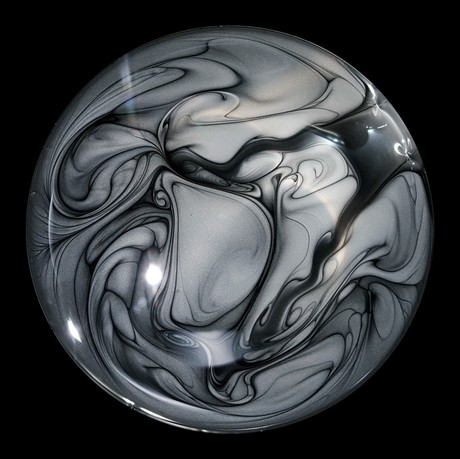High-yield creation of conductive graphene inks

A new method for producing high-quality conductive graphene inks has been developed by a research collaboration led by the University of Cambridge. The method has been published in the journal ACS Nano.
Conductive inks based on graphene and layered materials are useful for a range of applications, including printed and flexible electronics such as radiofrequency identification (RFID) antennas, transistors or photovoltaic cells. And with the Internet of Things predicted to lead to new connectivity within everyday objects, including in food packaging, there is a clear need for the cheap and efficient production of electronic devices using stable, conductive and non-toxic components.
Researchers at the Cambridge Graphene Centre, working in collaboration with the Bruno Kessler Foundation and Queen Mary University of London, developed a method that uses ultrahigh shear forces in a microfluidisation process to exfoliate graphene flakes from graphite — up to 100 g of flakes per litre. The process converts 100% of the starting graphite material into usable flakes for conductive inks, avoiding the need for centrifugation and reducing the time taken to produce a usable ink.
Using the most efficient rheology modifiers and stabilisers, the microfluidised graphene mixture was optimised for screen printing. As noted by lead author Panagiotis Karagiannidis, from the University of Cambridge, “The motivation was the need for layers with low sheet resistance to be produced by screen printing using inks with high concentration.”
As well as graphene, the method can easily be applied to other layered materials, such as hexagonal boron nitride or transition metal dichalcogenides. This will provide a family of printable circuit components — conductor, insulators and semiconductors — with which to build a variety of printed electronics with different functionalities.
The high-yield inks contain a high concentration of chemically unmodified few-layer graphene, leading to high conductivity of the final printed material. The inks also give an excellent sheet resistance below 2 Ω/sq, suitable for RFID antennas and electrodes in optoelectronic or energy storage devices.
“Microfluidisation is a huge leap ahead towards applications of affordable and environmentally friendly graphene inks in organic photovoltaics, RFID antennas, electrically conductive coatings or nanocomposites,” said Mar García-Hernandez, leader of the Graphene Flagship Work Package Enabling Materials. “The method is certainly well suited for the synthesis of a variety of other layered material inks, which will certainly enlarge the scope of applications of layered materials in real-world devices.”
An important issue for the use of graphene inks in printed electronics and other applications is scalability — producing inks and dispersions in large enough quantities for industrial applications. With the 100% yield of the microfluidisation method, it is now possible to produce high-quality graphene in sufficient quantities for commercial products.
Inks produced using this method have already been commercialised via a University of Cambridge spin-out company, Cambridge Graphene, which was recently acquired by engineering solutions company Versarien. The inks are also supplied to Graphene Flagship partner Novalia for use in its interactive touch-based printed electronic demos.
“This is an important conceptual advance and will significantly help the innovation and industrialisation goals of the flagship,” said Andrea Ferrari, director of the Cambridge Graphene Centre and science and technology officer of the Graphene Flagship. “The fact that the process is already licensed and commercialised indicates how it is feasible to cut the time from lab to market even during the lifetime of the flagship.”
Wireless innovation transmits vast amounts of data
Researchers have developed a machine-learning system that curves ultrahigh-frequency signals...
Ricoh chooses u-blox module for long-lasting GNSS performance
The Ricoh Theta X camera incorporates the ZOE-M8B GNSS module from u-blox, allowing users to...
Single-step 3D printing method to create tiny robots
The breakthrough enables the mechanical and electronic systems needed to operate a robot to be...






